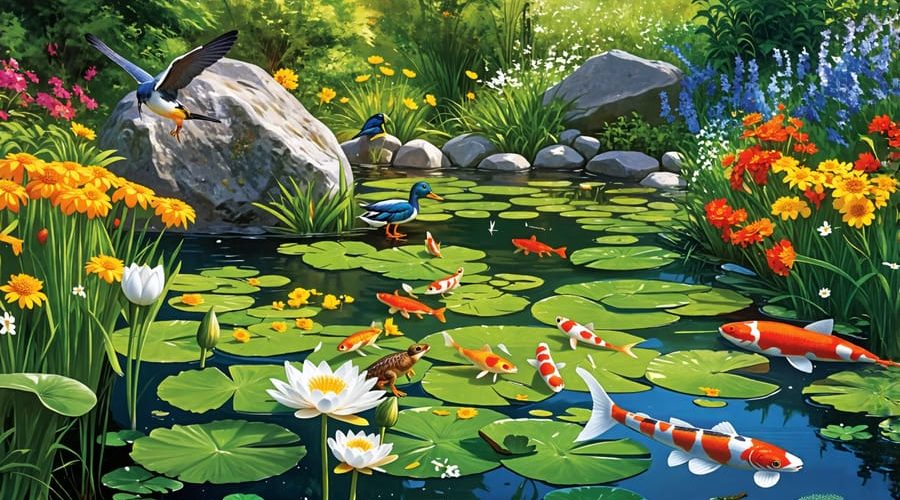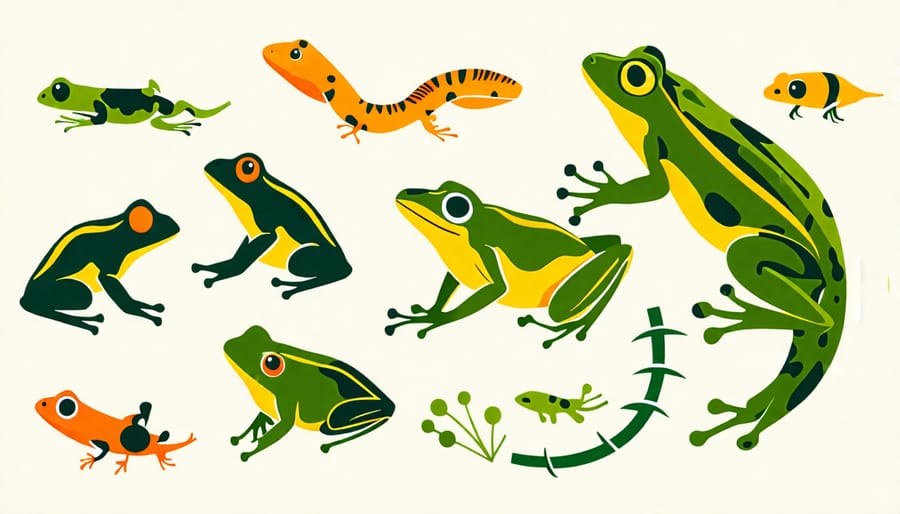
Create Your Own Backyard Haven: Exploring the Diverse Wildlife of Pond Habitats
Create a small haven by attracting diverse wildlife to your pond. First, introduce native water plants like water lilies and marsh marigolds to provide essential cover and food. These plants not only enhance the visual appeal but also create a thriving ecosystem. Next, incorporate varying depths within the pond to accommodate different species such as frogs, dragonflies, and fish, which require specific conditions for breeding and shelter. Third, construct features like rocks and logs to offer habitats for insects and small animals, promoting biodiversity. Finally, maintain a healthy balance by avoiding chemical pollutants and ensuring clean water, which supports the pond’s natural inhabitants. Transform your garden into a vibrant sanctuary by creating a wildlife pond that teems with life and beauty.
The Microcosm of Pond Life
Invertebrates: The Unsung Heroes
Invertebrates may not always steal the spotlight, but they play a starring role in the vibrant stage of pond life. Take a closer look beneath the surface, and you’ll find an array of insects like dragonflies, water striders, and beetles elegantly skimming the water or diving beneath. These tiny marvels do more than just flit around; they’re critical in maintaining pond health. By controlling mosquito populations, for example, dragonfly larvae are natural pest managers.
Crustaceans, such as freshwater shrimp and water fleas, are equally remarkable. These small creatures help keep algae levels in check and serve as a crucial food source for fish and amphibians, making them essential to the pond’s food web. Their scavenging habits contribute to the breakdown of organic material, turning waste into nutrients that support plant life—a process that, in turn, enhances water quality.
Creating a thriving habitat for these invertebrates involves nurturing a balanced environment. Consider planting submerged and floating vegetation to provide shelter and breeding grounds. Each plant offers a habitat for invertebrates to flourish, lending a beautiful and functional aesthetic to your pond. Not only do these unsung heroes add to the visual charm, but they also endow your pond with resilience and vitality, making them undeniably worth celebrating in any garden pond design.

Aquatic Birds: Elegant Visitors
Aquatic birds bring a touch of grace and life to any pond habitat, each species lending beauty and balance to the ecosystem. Among the frequent visitors you might spot, Mallards are perhaps the most well-known. Their vibrant green-headed males and subtle brown females often paddle leisurely across the water, searching for food while delighting onlookers with their quacks. Another elegant species, the Great Blue Heron, stands statuesque by the water’s edge. These expert fishers rely on keen eyesight and lightning-fast reflexes to catch small fish and amphibians.
Then there’s the picturesque Canada Goose, a seasonal visitor with its iconic honking call. They play a crucial role in their ecosystem by grazing on aquatic plants, which helps maintain a healthy pond environment. Pied-billed Grebes might also make an appearance, specializing in diving for insects and other aquatic critters, contributing to the ecological balance.
Attracting these elegant visitors to your pond can be as simple as ensuring a natural landscape with native plants and maintaining clean, unpolluted water. Consider adding a few reeds or water lilies for cover and nesting spots. Watching these birds will not only enhance your outdoor aesthetic but also support a vibrant, balanced pond ecosystem.
Amphibians and Their Vital Roles
The Lifecycle of Frogs in Ponds
Frogs are fascinating creatures that play a vital role in pond ecosystems throughout their life stages. Starting life as gelatinous clusters of eggs floating near the water’s surface, frog embryos develop swiftly. Within days to weeks, depending on the species and temperature, tiny tadpoles hatch and begin their underwater adventure. Tadpoles are incredible swimmers, feeding on algae and organic matter, which helps maintain the balance of the pond ecosystem.
As they grow, tadpoles undergo a miraculous transformation called metamorphosis. Their bodies gradually reshape, growing hind legs first, followed by front legs, while their tails shorten and lungs develop. This metamorphic process can last several weeks to several months, during which the developing frog begins to explore beyond the water’s edge.
Upon reaching adulthood, frogs are adept hunters, snatching up insects and other prey with their sticky tongues, which keeps potential pest populations in check. Adult frogs often reside near ponds, using these habitats as breeding grounds and hunting territories. By providing a diverse environment with aquatic plants and shaded areas, pond enthusiasts can create a welcoming haven for these charming amphibians and enjoy the delightful chorus of frog calls that signal a healthy pond ecosystem.

The Importance of Newts
Newts are fascinating and vital residents of your pond habitat, playing an essential role in maintaining ecological balance. These charming amphibians are effective natural pest controllers, feasting on a variety of insects like mosquitoes, flies, and other pesky bugs, which can become nuisances if left unchecked. By consuming these insects, newts help keep their populations under control, ensuring a healthier and balanced pond ecosystem. This is particularly beneficial for water gardeners and pond enthusiasts who wish to reduce the need for chemical pest control methods, promoting a more organic and environmentally friendly approach.
Beyond pest control, newts also signal a thriving pond environment. Their presence indicates good water quality and a well-structured habitat, which supports various life stages of newts, from larval to adult. If you’re hoping to invite newts to your pond, consider creating shady areas with floating plants and providing logs or rocks for shelter. These efforts will not only enhance the aesthetic appeal of your pond but also contribute to a vibrant and dynamic aquatic community.
Fish as the Stars of the Pond
Top Pond Fish Species
If you’re looking to add some vibrant life to your pond, Koi and Goldfish are the top contenders. These beautiful fish not only enhance the aesthetics of your pond but also add a tranquil presence to your outdoor space. Koi are known for their striking colors and patterns, and while they can be a bit high maintenance, they’re well worth the effort. They thrive in larger, well-filtered ponds with plenty of space to swim and areas to hide, as they can grow quite large over time.
Goldfish, on the other hand, are more suited for smaller ponds. They’re hardy, adaptable, and come in various colors and fin types. Like Koi, Goldfish appreciate clean, oxygen-rich water and a diet that includes a mix of high-quality fish pellets and natural forage like insects and plants.
Both species bring not just visual delight but also ecological benefits, helping to control algae growth and insect populations. With the right care, Koi and Goldfish can become the shimmering jewels of your pond ecosystem, creating a lively attraction for both family and friends to enjoy.
Balancing Fish Population
Maintaining a balanced fish population is key to a healthy pond ecosystem. Start by identifying the type and number of fish your pond can support, based on its size and available resources. Overcrowding can lead to issues like oxygen depletion and excessive waste, which harm the delicate balance of your pond. A good rule of thumb is to allow for about one inch of fish per square foot of water surface.
Introduce a mix of fish species that thrive together, such as goldfish and koi, which can coexist peacefully while each playing a role in the ecosystem. Regularly monitor and adjust fish numbers by considering natural breeding cycles and potential predators. Be sure to occasionally check water quality, including oxygen levels and pH, to ensure conditions are suitable for your fish.
Feed your fish only what they can consume in a few minutes—overfeeding leads to waste buildup. By maintaining a balanced fish population, you create a thriving, self-sustaining habitat that benefits all your pond’s inhabitants.
Creating a Pond-Friendly Environment

Choosing the Right Plants
Selecting the right aquatic plants is a delightful step in crafting a thriving pond habitat. For beginners and seasoned pond lovers alike, it’s essential to choose plants that not only beautify but also nurture the ecosystem. Start with native plants, like water lilies and pickerelweed, known for providing excellent shelter and food for fish and insects. Submerged plants, such as hornwort, oxygenate the water and offer hiding spots for smaller creatures. Don’t forget floating plants like duckweed—they reduce algae by blocking sunlight and provide shade. It’s a joyful process that supports pond residents and adds enchanting patterns to your water garden, making it a personal paradise for you and the wildlife it welcomes.
Regular Pond Maintenance
Maintaining a thriving pond habitat is simpler than you might think, and it’s crucial for attracting a diverse range of animals. Begin by regularly skimming the surface to remove leaves and debris, which can decompose and harm water quality. Consider investing in a pond net to make this task more manageable. During the warmer months, remember to trim back any overgrown aquatic plants. This allows sunlight to penetrate the water, supporting plant life and creating hiding spots for fish and amphibians. Install a pond pump to keep the water circulating—this prevents stagnation and promotes oxygenation, essential for healthy pond animals. Finally, monitor water levels and top up with rainwater when necessary, as this helps maintain a stable environment that encourages wildlife to thrive. Embrace these simple tasks, and your pond will become a bustling hub of natural activity.
Conclusion: Transforming Your Pond
Creating your own pond habitat offers an incredible journey of growth and discovery. As you transform your backyard, you’ll find joy not only in designing a beautiful water feature but also in supporting a vibrant ecosystem. The plants and structures you choose can make a substantial impact, providing shelter for frogs, dragonflies, and a myriad of other pond creatures. Every ripple in the water and every lily pad offers a home or food source for these fascinating animals. By fostering this small world, you’ll enjoy an ever-changing spectacle as the seasons evolve, attracting a bustling community of wildlife that supports broader ecological health. Begin with small steps and experiment as you go. Whether you’re starting from scratch or enhancing an existing pond, remember that your efforts contribute to both a personal oasis and a vital resource for local wildlife. Embrace the adventure and relish the countless joys of pond gardening!
